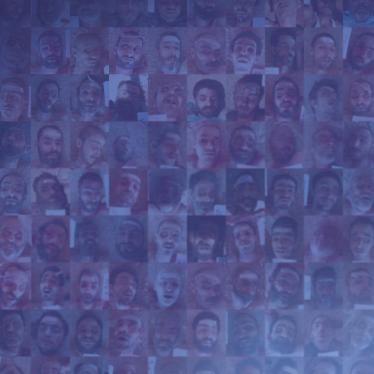(New York) - Eastern Libya is littered with massive amounts of unexploded ordnance, abandoned and unsecured weapons and munitions, and recently-laid landmines from the fighting since February 2011, posing a great threat to civilians, Human Rights Watch said today.
Human Rights Watch called on the transitional authority in eastern Libya to safeguard munitions depots in areas under its control. The authorities should also secure, monitor, and clear areas contaminated by unexploded ordnance (UXO) and abandoned munitions, Human Rights Watch said.
"When ordinary civilians, even children, can walk into a weapons depot and remove anti-tank missiles, landmines, and surface-to-air missiles capable of shooting down a civilian aircraft, you have a real problem," said Peter Bouckaert, emergencies director at Human Rights Watch, who just completed two weeks of research in eastern Libya. "The rebel authorities should take urgent action to secure the arms depots under their control."
On April 2, the United Nations issued a warning on the threat from landmines and explosive remnants of war in Libya. The urgent need is for emergency risk education, safeguarding weapons depots under rebel control, mine clearance, and the marking and disposal of explosive ordnance, Human Rights Watch said.
Abandoned Weapon and Munitions Storage Facilities
As the Gaddafi government lost control over eastern Libya starting in late February 2011, anti-government rebels and civilians gained access to massive military weapon and munitions depots, abandoned by government forces. Among those depots are the 60-bunker Hight Razma facility on the eastern outskirts of Benghazi and a 35-bunker facility on the eastern outskirts of Ajdabiya, a city that has changed hands between government and opposition forces several times in recent weeks. Both storage facilities are packed with weapons and munitions, and readily accessible to civilians.
Human Rights Watch researchers visited the Ajdabiya storage facility on March 26, as opposition forces retook the city. No guards were defending the facility, allowing civilians to haul away munitions.
Human Rights Watch inspected 20 of the 35 weapons bunkers. Inside were thousands of 122mm Grad rockets - one single bunker contained more than 2,000; hand-held SA-7 Grail surface-to-air missiles capable of shooting down a civilian airplane; various guided anti-tank missiles, including AT-2 Swatter, AT-3 Sagger, AT-4B Spigot, AT-14 Spriggam, and AGM-22; hand-held rocket-propelled grenade launchers (RPG-7); 76mm and 106mm high-explosive squash-head (HESH) rounds; 73mm PG-15V anti-tank missiles; 105mm howitzer high explosive projectiles; 105mm white phosphorus artillery projectiles; 105mm High-Explosive Anti-Tank (HEAT) rounds for recoilless guns; 100mm, 122mm, and 155mm artillery shells; 51mm, 60mm, 81mm, and 120mm high explosive mortar rounds; 81mm white phosphorus mortar shells; and many other types of munitions.
A UN Mine Action Service investigator working in cooperation with Human Rights Watch found similar weapons and munitions stored at the Hight Ramza depot in Benghazi, which also has 12 full bunkers of plastic PRBM antivehicle mines, large stocks of napalm, large numbers of anti-aircraft guns of different caliber, as well as stocks of plastic explosives. At the Benghazi depot, civilians have been looting antivehicle mines to re-use the explosives for fishing.
On the battlefield around Ajdabiya and further west, Human Rights Watch saw all of these weapons, often in the hands of people with no previous military experience. Various types of anti-aircraft guns were commonly used by rebel fighters, as were RPGs, mortars, artillery pieces, rocket launchers, SA-7 Grail missiles, and recoilless guns. Human Rights Watch also observed rebels using Grad rocket launchers around the town of Ras Lanuf. Grad rocket systems are capable of launching up to 40 122mm missiles in one salvo at targets from four to 40 kilometers away. They can cause large-scale civilian casualties if deployed indiscriminately against civilian-populated areas, or by people untrained in their use.
The unchecked looting of the arms depots in eastern Libya poses a direct risk to civilians, Human Rights Watch said. The arms depots may accidentally explode if munitions are carelessly moved. The weapons could also pose direct dangers to civilians if used by untrained people, abusive rebel groups, or others willing to engage in terrorist attacks.
An arms depot near Benghazi accidentally exploded on March 4 as untrained people were removing munitions, killing at least 27.
Abandoned and Unexploded Ordnance
In recent weeks, the battlefield in eastern Libya has shifted rapidly from town to town along the coastal road, as the rebels advanced or were pushed back by government forces. In the process, large stocks of munitions have been left behind, either abandoned by retreating troops or unexploded after combat operations. The failure or "dud" rate of munitions is compounded by the age of many of the munitions, dating back to the 1960s and 1970s. The soft sand areas in which much of the fighting takes place adds to detonator failures.
Among the unexploded and abandoned ordnance documented by Human Rights Watch were large numbers of 155mm high-explosive artillery projectiles and 81mm mortar rounds left behind on the outskirts of Ajdabiya by retreating government forces; an unexploded AT-14 laser-guided Spriggan anti-tank missile found on the outskirts of Benghazi after government forces retreated; various unexploded artillery rounds; unexploded Grad rockets; abandoned RPG and tank rounds; containers of volatile bulk propellant used by artillery and tanks - including some exposed to direct sun, which makes them a highly unstable explosive threat; 106mm HEAT rounds; SA-7 Grail missiles; AT-3 Sagger and AT-4 Spigot anti-tank missiles; 107mm rockets; and various types of small arms and anti-aircraft ammunition.
In addition, the Libyan Air Force has hit several munitions storage facilities in an attempt to deny rebel forces the weapons. In recent days, coalition forces have also targeted munitions storage facilities under the control of government forces. Human Rights Watch saw damaged munitions warehouses in the east with large amounts of unexploded ordnance strewn around the premises from the explosions, posing a danger to civilians. These partially destroyed warehouses exist at the main arms depot in Ajdabiya, as well as the Hight Ramza ammunition storage facility in Benghazi.
Airstrikes by international coalition forces on Libyan government military targets have added to the problem of unexploded ordnance. Many of the targets struck by the military alliance have been ammunition vehicles, as well as tanks and artillery pieces loaded with munitions. As a result, many of the munitions from the struck vehicles get "kicked out" and remain strewn around the vehicles, posing a threat to civilians.
In some cases, crowds of people, including families with children, have visited the strike sites to take mementoes. Human Rights Watch documented dozens of unexploded 122mm Grad rockets lying around the main highway between Benghazi and Ajdabiya after coalition airstrikes, unexploded Grad rockets still in the launch tubes of destroyed launchers, and live, unexploded Howitzer rounds still in the body of self-propelled Howitzer vehicles that had been struck, while children were climbing on the destroyed vehicles (which resemble tanks).
"We saw many instances of Libyans collecting souvenirs from destroyed armored vehicles or picking up explosive ordnance," Bouckaert said.
Antipersonnel and Antivehicle Mines
Libyan authorities have vast stockpiles of both antipersonnel and antivehicle mines, and have deployed both during the recent conflict. On March 30, Human Rights Watch confirmed the presence of a newly laid minefield with antipersonnel and antivehicle mines on the outskirts of Ajdabiya. Since then, a second minefield, also consisting of antivehicle and antipersonnel mines, has been discovered in the same general area, surrounding an abandoned tank position of government forces.
Human Rights Watch also confirmed the existence of a large minefield, unmarked except for the barbed wire surrounding it, around the main weapons depot in Ajdabiya. It is presumed that other weapons depots in Libya are similarly mined.
Human Rights Watch has identified the mines that government forces deployed around Ajdabiya. They include Chinese-produced Type-72 metal-encased antivehicle mines and Brazilian-produced T-AB-1 antipersonnel mines, which are mostly plastic and thus very difficult to detect.
"The local population urgently needs mine risk education," Bouckaert said. "This will increase awareness and minimize casualties from mines and unexploded ordnance."




